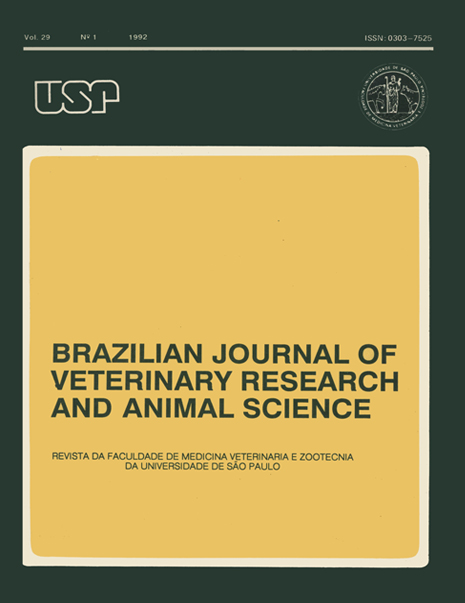Use of white rat as an alternative biological system for the study of rabies virus
DOI:
https://doi.org/10.11606/issn.1678-4456.bjvras.1992.51953Keywords:
Rabies virus, Diagnosis (rabies), MiceAbstract
The response of white rats (Rattus norvegicus) and mice (Mus musculus) to 8 field isolates of rabies virus was assessed in 441 white Wistar strain rats and in the same number of albino mice of both sexes, aged between 19 - 31 days and randomly divided into 24 groups of 8 - 10 animals each. The 20% (w/v) bovine and canine rabid brain suspensions were inoculated intracerebrally using 0.05 ml and 0.03 ml, respectively for a single rat and mouse dose. The animals were observed daily for rabies signs and symptoms and deaths for up to 21 days post inoculation and brains of dead animals were submitted to Fluorescent Antibody (FA) examination. For early recognition of Negri bodies, each group had sacrificed one animal daily from the third post inoculation day. The incubation period, the clinical disease and the time needed for the early detection of rabies through the FA testing were statistically not significant at alfa level of 0.05, although in mice the signs and simptoms of rabies were detected several hours earlier than in rats. Both species have revealed a susceptibility of 100% and aerophobia and spasmodic signs, though always detected in mice, were not observed in rats after their manipulation. The use of white rats for isolation and identification of rabies virus is feasible and the authors suggest their use as an alternative species to mice especially for those laboratories that deal with research and diagnosis of rabies.Downloads
Download data is not yet available.
Downloads
Published
1992-06-01
Issue
Section
PREVENTIVE VETERINARY MEDICINE
License
The journal content is authorized under the Creative Commons BY-NC-SA license (summary of the license: https://
How to Cite
1.
Cortes V de A, Côrtes J de A. Use of white rat as an alternative biological system for the study of rabies virus. Braz. J. Vet. Res. Anim. Sci. [Internet]. 1992 Jun. 1 [cited 2026 Jan. 18];29(1):61-6. Available from: https://revistas.usp.br/bjvras/article/view/51953





